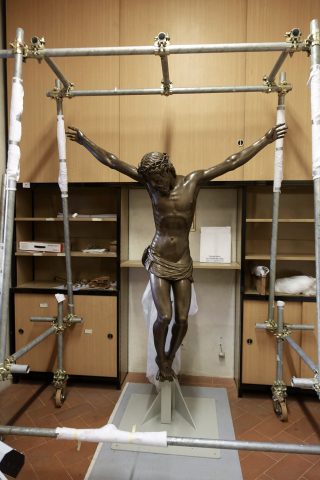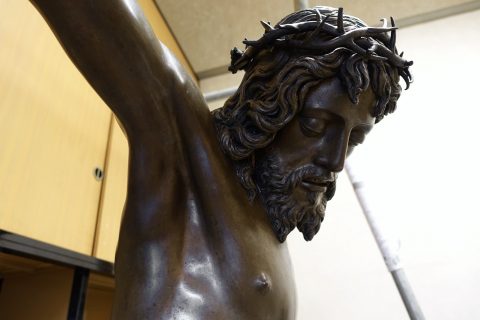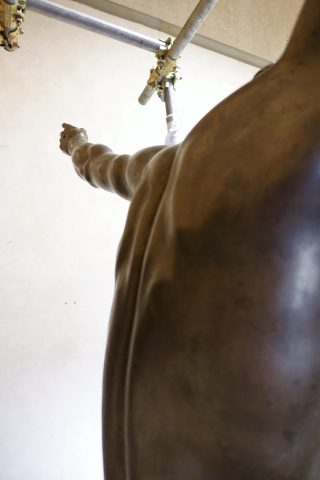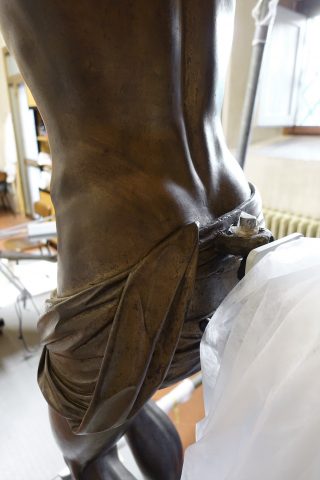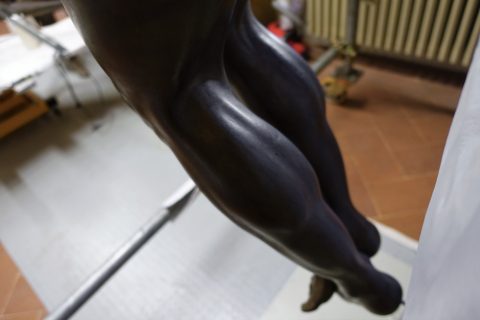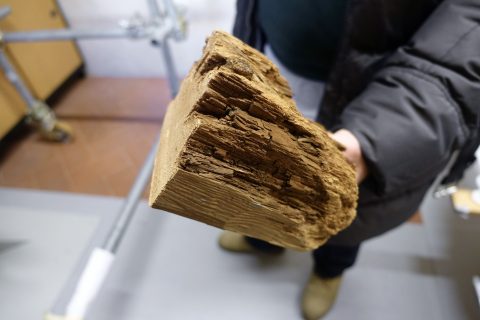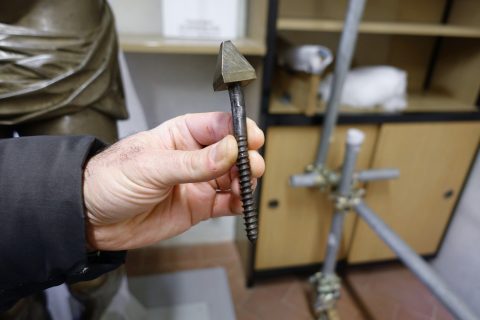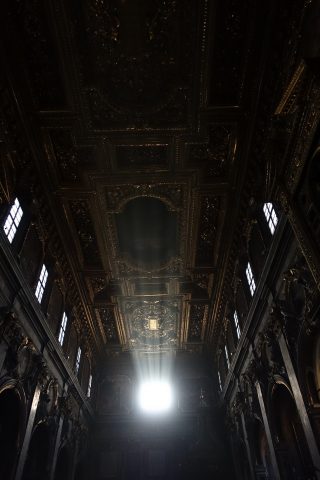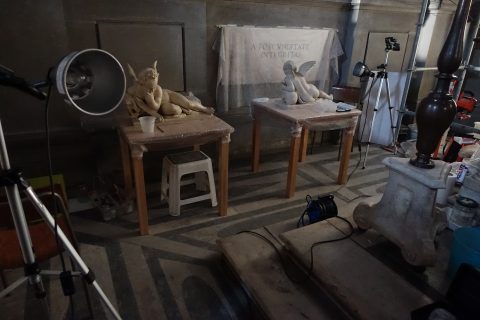In Florence for a very close encounter with the only sculpture Giambologna made for himself
- Giambologna, crucified Christ, 1590-1594, Chiesa della Santissima Annunziata, Florence.
- Giambologna, crucified Christ, 1590-1594, Chiesa della Santissima Annunziata, Florence.
- Giambologna, crucified Christ, 1590-1594, Chiesa della Santissima Annunziata, Florence.
- Giambologna, crucified Christ, 1590-1594, Chiesa della Santissima Annunziata, Florence.
- Giambologna, crucified Christ, 1590-1594, Chiesa della Santissima Annunziata, Florence.
- Piece of wood from the original cross.
- Original nail.
- Central nave, Chiesa della Santissima Annunziata, Florence,
- Chapel of Santa Maria del Soccorso, CHiesa della Santissima Annunziata, Florence. Currently under restoration.
- Chapel of Santa Maria del Soccorso, CHiesa della Santissima Annunziata, Florence. Currently under restoration.
Among the many outstanding works of art preserved in the Florentine church called “della Santissima Annunziata” a place of honour is taken by the seminal crucified Christ that Giambologna sculpted for himself between 1590 and 1594, after the artist bought the chapel entitled to “Santa Maria del Soccorso” for being buried after his death, right behind the church’s main altar. As Nicola Salvioli, the restorer who cleaned and studied the piece during the ongoing restoration campaign of the chapel said to Cfa during a private view occurred a couple of months ago: “this piece is most of all the result of extraordinary technological capabilities, those same capabilities thanks to which the artist was able to create the famous equestrian monument dedicated to Cosimo I”, that is largely considered his masterpiece.
Mr. Salvioli, based in Florence and graduated at the Opificio delle Pietre Dure’s Scuola di Alta Formazione in 2002, is a freelance restorer specialized in metal and bronze works of art. Such as the famous Ghiberti’s Gate of Heaven for Santa Maria del Fiore’s baptiser, that Salvioli restored in collaboration with the Opificio delle Pietre Dure between 2010 and 2012. Or the so called Ricciardi Head of Horse, an outstanding Hellenistic bronze from the second half of the VI century BC that he restored last year in occasion of the exhibition Pathos&Power (Florence, Los Angeles, New York).
“Like the horse in Piazza della Signoria – Salvioli underlines – this Christ is a single piece of bronze, and it’s very, very thin. Giambologna was the only artist of his time able to produce such a light and refined monumental piece”. And effectively, considering that it is almost a full-scale human body, the Christ weights less than 150 kilograms only. Only the Greeks, before Giambologna, were able to reach such achievements in bronze fusion. “During the Medieval age, or the Renaissance, a sculpture of this kind would have been made with four or five different pieces at least – Salvioli explains. While in this case only the crown of thorns and some elements of the hands which cover passages needed to access to the inside of the sculpture were added after the fusion”.
In the occasion of the commission of the monument for Grand Duke Cosimo I de’ Medici Giambologna, under the permission of the court, had extended his personal workshop located on via Borgo Pinti (not far from the Santissima Annunziata). He had bought an adjacent building in order to have enough space to work on the prestigious monument. To make such a bronze fusion a hole in the ground approximately two times bigger than the entire sculpture was in fact required.
Originally the Christ’s surface, or its “skin”, as Salvioli calls it, was quite shiny and had a different color. Giambologna usually perfected the bronzes with a specific kind of reddish purple varnish he only knew how to properly use. Trances of the original patina have been found between the Christ’s lips and fingers. Unlike the second version of this sculpture, which still bears its original patina (and it’s currently preserved in Saint Michael Church in Munich), the one in Santissima Annunziata had probably been employed during the XVIII century to form a mold of it, in order to make a casting – and effectively a copy of the sculpture is currently in the Victoria and Albert museum in London. Traces of a powerful abrasive substance used to clean the sculpture have indeed been found on the Christ’s thighs.
In regards with the muscles’ anatomy, Salvioli notices that the Christ’s body is a clearly idealized one which looks younger than 33-years-old. Nevertheless wrists, elbows and shoulders are stretched, likely dislocated by the heaviness of the dying body itself. Calf and thigh’s muscles are slightly tensed in order to represent the pressure Christ is putting on the basis of the cross to alleviate the pain caused by the big nails stuck in his hands. His diaphragm is wide open and placed almost outside the rib cage. The son of God is choking.
The piece, cleaned and studied thanks to the money provided by Friends of Florence, was secured at the cross by two hooks placed at the bottom of the body and two hinges bearing big curved nails. The moorings at hands and feet were needed just to keep the structure steady. Since the chapel it was made for is located at the centre of the apse, the bronze crucifixion was in effect the most important one in the church. The sculpture will be reinstalled in the position wished by Gimbologna as soon as the restoration of the chapel is ready. But since all the money needed to complete the work has not been found yet, nobody at the moment can say exactly when this will happen…
November 25, 2020

